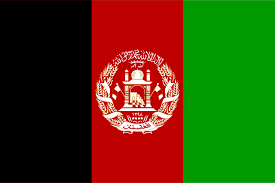Afghanistan flag Colors Code hex, png svg
Last updated on July 21st, 2024 by Editorial Staff
The flag of Afghanistan has a rich and complex history, with numerous changes reflecting the country’s turbulent political landscape. Here’s a detailed look at its history, colors, and their meanings:
Historical Evolution of the Afghan Flag
- Early Flags (18th – 19th Century):
- The earliest flags of Afghanistan were predominantly tribal and simple, often featuring a solid color such as black or green, sometimes with a single symbol like a white crescent.
- 1901-1919 (Reign of Habibullah Khan):
- A solid black flag was used, symbolizing the dark ages Afghanistan was emerging from.
- 1919-1929 (Amanullah Khan):
- After gaining independence from British influence, a tricolor flag was introduced in 1928 with black, red, and green vertical stripes and an emblem in the center. The colors represented the historical phases: black for past, red for blood shed for independence, and green for hope and prosperity.
- 1929-1973 (Various Changes):
- Several changes occurred, often reflecting different regimes and ideologies. The most notable change was in 1930 under Mohammed Nadir Shah, when a new emblem featuring a mosque with a mehrab (prayer niche) and minbar (pulpit) was added in the center, along with the national motto.
- 1973-1978 (Republic):
- Under President Daoud Khan, the flag kept the tricolor design but changed the emblem to reflect the new republican regime.
- 1978-1987 (Democratic Republic of Afghanistan):
- The flag was modified significantly during the communist era, featuring a red flag with a golden emblem, then later returning to a tricolor with a new emblem reflecting socialist symbols like a cogwheel, sheaves of wheat, and a star.
- 1987-1992 (Republic of Afghanistan):
- Another variation was introduced, reverting to the tricolor with a new emblem featuring Islamic symbols along with socialist elements.
- 1992-2001 (Islamic State of Afghanistan, Taliban era):
- The flag saw several changes during this period. Under the Mujahideen, a green-white-black tricolor was adopted with a different emblem. The Taliban introduced a plain white flag with the Shahada (Islamic creed) inscribed in black.
- 2002-Present:
- After the fall of the Taliban in 2001, a new flag was introduced. The latest version, adopted in 2004, is a vertical tricolor of black, red, and green with the national emblem in white in the center.
Colors and Their Meanings
- Black:
- Represents the dark, oppressive past and the difficult periods Afghanistan has endured, including foreign domination and internal strife.
- Red:
- Symbolizes the blood shed for independence, resistance, and sacrifice of the Afghan people.
- Green:
- Represents Islam, prosperity, and the hope for a peaceful and stable future.
Emblem
The emblem, as of the latest design, features:
- A mosque with a mehrab (prayer niche) and minbar (pulpit), symbolizing faith and the religious foundation of the state.
- Two flags on either side of the mosque.
- Sheaves of wheat encircling the emblem, representing agriculture and the country’s reliance on it.
- The inscription “Afghanistan” and the year 1298 in the Islamic calendar (1919 in the Gregorian calendar), marking the year of independence from British influence.
This flag, with its colors and emblem, encapsulates the history, struggles, faith, and aspirations of the Afghan people.
Guess the Flags Quiz
Sharing is caring 🤗

National Symbols 👇
- 🏁 National Flags
- 🦁 National Animals
- 🐦 National Birds
- 🌻 National Flowers
- 🌴 National Trees
- 🥭 National Fruits
- 🍹 National Drinks
- 👴 National Founders
- ☘️ National Emblems
- 🍲 National Dishes
- 🏛️ National Monuments
- ✍️ National Poets
- 🕌 National Mausoleums
- 🎺 National Instruments
- 🦸 National Heroes
- 📆 National Days

